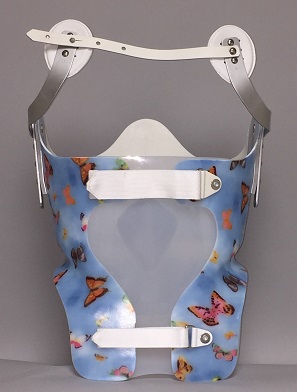Boston Kyphosis Brace
The human spine, when viewed from the side, has a natural inward sway at the bottom and an outward sway at the top. These back-to-front curves are considered normal and change during the course of normal human growth, development and aging. The inward sway is referred to as lordosis, the outward sway is termed kyphosis.
Kyphosis is defined as a deformity of the upper spine causing an exaggerated (more than 50°) outward curve. Technically this condition is known as hyper kyphosis, though it is commonly referred to as simply kyphosis. Our Kyphosis brace corrects this condition.
Studies have shown there is a natural range of these front-to-back and back-to-front curves. If either of these curves begin to fall out of the natural range, orthotic management may be considered. The most common condition is referred to as hyperkyphosis, meaning the upper outward sway is larger than it should be.
Postural Kyphosis and Scheuermann’s Kyphosis
 In adolescents, the most common types of hyperkyphosis are postural kyphosis and Scheuermann’s kyphosis. Postural kyphosis is as it sounds—caused by poor posture, maybe some weakened muscles and the shoulders may be rotated forward. In postural kyphosis, the bones of the spine are typically not affected. Scheuermann’s kyphosis, first described by a Danish radiologist, Dr. Scheuermann, by contrast is defined by having three consecutive bones of the spine wedged. Scheuermann’s kyphosis is most common in boys aged 8-13.
In adolescents, the most common types of hyperkyphosis are postural kyphosis and Scheuermann’s kyphosis. Postural kyphosis is as it sounds—caused by poor posture, maybe some weakened muscles and the shoulders may be rotated forward. In postural kyphosis, the bones of the spine are typically not affected. Scheuermann’s kyphosis, first described by a Danish radiologist, Dr. Scheuermann, by contrast is defined by having three consecutive bones of the spine wedged. Scheuermann’s kyphosis is most common in boys aged 8-13.
What To Do
Children diagnosed with Scheuermann's kyphosis may be able to stop the progression of kyphosis by wearing a back brace (thoraco lumbral sacral orthosis, TLSO) while their bones are still growing. When professionally fit and worn for the prescribed time, TLSO braces can be effective at straightening a kyphosis-affected spine and preventing further curvature and related problems.
A study of bracing with a specially designed Kyphologic® brace has shown average in-brace corrections of greater than 15° when wearing it.

